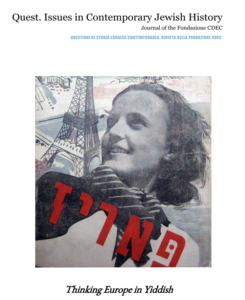Ten years of Quest, building bridges between different academic traditions
 Launching an English language, online, open–access journal devoted to publishing contributions on any aspect of Jewish history from the 18th century onwards was not an easy challenge at all. But ten years later, “Quest. Issues in Jewish Contemporary History”, the periodical published by the Fondazione Centro di Documentazione Ebraica Contemporanea – CDEC of Milan has definitely made it.
Launching an English language, online, open–access journal devoted to publishing contributions on any aspect of Jewish history from the 18th century onwards was not an easy challenge at all. But ten years later, “Quest. Issues in Jewish Contemporary History”, the periodical published by the Fondazione Centro di Documentazione Ebraica Contemporanea – CDEC of Milan has definitely made it.
“This anniversary shows us that the project was valuable. In the last ten years we saw the journal get progressively known and appreciated by the international scientific community”, explains to Pagine Ebraiche Guri Schwarz, historian of the University of Genoa, Quest co-founder and current scientific director. “Thanks to CDEC’s support and long-term vision, we had the opportunity to pursue our goal of promoting a dialogue between different academic traditions, which is working”. A remarkable achievement came last spring, when Quest was acknowledged as a class A scientific periodical.
“It is a very important achievement, for us. In Italy in order to become university professor, one need to publish in class A academic journals and there are a few of them dedicated to Jewish studies. Moreover, Quest contributed to making Jewish studies known in Italy, where they are not so followed”, says Guri Schwarz. In Italy, a country with a tiny Jewish minority and at the same time a long and rich Jewish past, “despite the fact that some significant scholarly works were and are being produced, the field has little autonomy and is confined to being a subset of wider disciplinary sectors (such as modern history, religious studies, Hebrew literature etc.)”.
“It is a fact that the U.S. represents the vital core of Jewish Studies worldwide”, reads the introduction to Quest last issue by Guri Schwarz. “This reflects availability of funding, the recognition awarded to the field within academic institutions and, of course, the quality of the works produced. Then there is Israel, with its own traditions and institutions, which also constitutes a crucial point of reference”.
“In the 21st century, if one wants to find a place in the global discussion in this field English is the obvious medium, but language is not the only barrier. A European scholar could find a way to be read by having his/her work translated into English and publishing in American academic journals. What is required though is, often, not a mere linguistic transformation, but an adaptation to a different cultural milieu. We must recognize that there are varying, sometimes diverging, certainly autonomous historiographic traditions that deserve to retain their identity and that – at the same time – could benefit from a closer dialogue”.
On this approach relies also the last monographic issue available on the recently renovated website and dedicated to the idea of Europe as seen by that vast cultural world that used to express itself in Yiddish. “An interesting idea was submitted to us – says Gury Schwarz – which arose from a conference held in Germany and which we accepted. This issue proposes a reflection on Yiddish not only as an expression of European culture, but also explores the ways in which European spaces, cultures, identities have been conceived and represented by the Yiddish-speaking world and how, and to what extent, the Yiddish cultural community has related to these concepts”.
